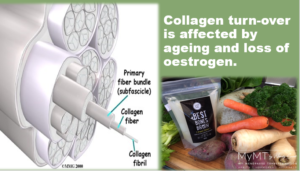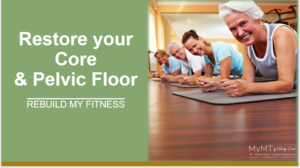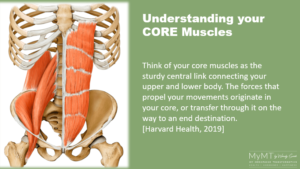Who knew that there were oestrogen receptors in our pelvic floor muscles? Did you? Or did you realise when you felt your stress incontinence becoming worse when you arrived in your 50’s?
Most of us already know that our pelvic floor muscles lose much of their elasticity due to childbirth, but during menopause these sling-like muscles are in the spotlight too. We lose the role of oestrogen in the central nervous system and also in the uro-genital areas at menopause. So, with numerous oestrogen receptors in the pelvic floor mucosa, the loss of oestrogen as we move through menopause reduces collagen turn-over in this important area. This is why a consistent theme in ageing studies is the increase in incontinence in post-menopausal women.
It’s also why, the MyMT Food Guide is packed full of nutritious recipes that help to improve our collagen intake and yes, this includes beautiful bone-broth soup for those who aren’t vegetarian.

With the turn-over of collagen affected during menopause because of our declining oestrogen, as menopause arrives and we lose oestrogen, the ligaments in our pelvic floor soften and can become a bit slack. It’s why the focus needs to be on our core and pelvic floor muscles as part of our exercise routines.

Core work supports your spine, especially the thoracic and lumbar regions. This is important if you are sitting most of the day.

That is why I have designed the Rebuild My Fitness 12 week online programme that moves women progressively through how to become more active and get back into exercise again. It’s so important as we age to get active again. And it’s why, included in this program is a module called, Restore Your Core and Pelvic Floor. And yes, those old Kegel exercises to strengthen your pelvic floor muscles matter, even though most of us are way past our post-natal days!
I’ve got a brief video to share with you as part of November is Exercise Month with MyMT™ but first I want to share with you the breathing routine that I want you to perform as you do your Kegel exercises.
Your Kegel Breathing Technique:
When you perform your pelvic floor contractions, please co-ordinate these with your breathing to get maximum results.
- EXHALE as you perform the Kegel contraction (this is when you contract your pelvic floor and perineal areas and draw the contraction upwards and inwards as I demonstrate on the exercise video and in the module).
- COUNT aloud as you hold your Kegel contraction as this ensures that you don’t hold your breath. Breath-holding is not part of your Kegel contraction routine.
Perform your Kegel Exercises Lying Down if you have weak pelvic floor muscles. If you have difficulties lying on the floor then lie on your bed with a pillow supporting your head. When you have mastered your Kegel exercises and you feel you are getting stronger, then you can move to sitting, standing, squatting (as in the module) or even movement-based Kegels. Note that if you leak when you stand or walk, then you need to build-up to performing your Kegel exercises in the standing position.
Please note that there are numerous health and exercise professionals who specialise in pelvic floor therapies, so please, if you feel you would like to progress faster or have one-on-one supervision, then ensure you find a REGISTERED practitioner in your community.
Wendy Sweet, PhD/ NZ Registered Exercise Specialist
References:
Harvard Health (2019). Gentle Core Exercises. Harvard Health Publications.
Weber M., Kleijn M., et al, (2015). Local Oestrogen for Pelvic Floor Disorders: A Systematic Review. PLoS ONE 10(9): e0136265.

